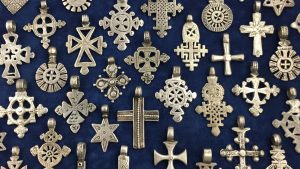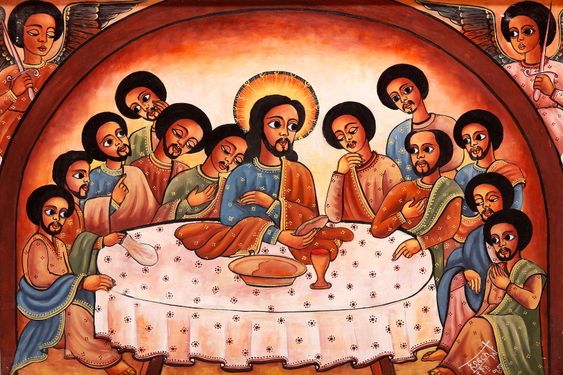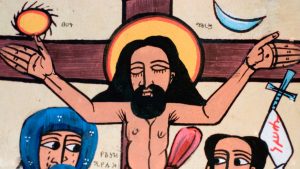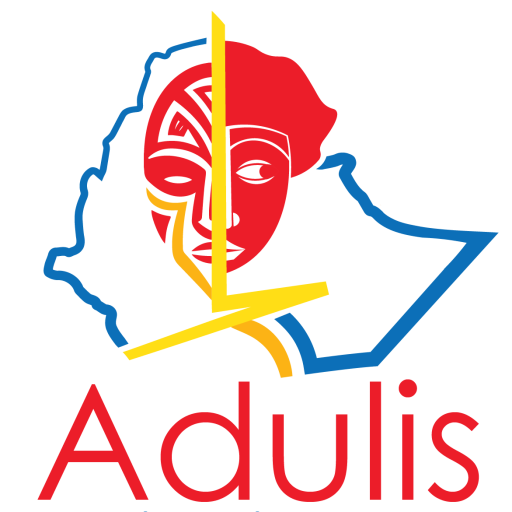
Get Up to 15% OFF Store wide – Limited time only
Menu
Get Up to 15% OFF Store wide – Limited time only

Ethiopian iconography and religious art represent a unique cultural and spiritual identity, developed over centuries and woven into the fabric of Ethiopian society. From the iconic Ethiopian crosses and vibrant illuminated manuscripts to the awe-inspiring rock-hewn
churches of Lalibela, Ethiopian art is distinguished within the global Christian art tradition. Ethiopian religious art is more than a cultural artifact; it is a deeply symbolic and sacred practice, reflecting the spiritual devotion of a nation that adopted Christianity in the 4th century. Today, these distinctive elements continue to inspire both worship and global admiration, offering insights into Ethiopia’s rich heritage and its enduring role in religious art.
Ethiopian Christian art originated in the 4th century when King Ezana of the Aksumite Kingdom converted to Christianity, making Ethiopia one of the earliest Christian nations in the world. This early adoption gave Ethiopian art a unique place in Christian iconography, allowing it to evolve independently of Western influences. “Ethiopian iconography is deeply rooted in a distinct Christian identity,” explains Aida Fekadu, a scholar of Ethiopian religious art. “It combines traditional African aesthetics with Christian themes, creating a visual language that’s both unique and sacred.”
Ethiopian iconography often depicts Biblical figures and Ethiopian saints, integrating local cultural elements for a distinctly Ethiopian essence. Unlike Western Christian art, which emphasizes realism, Ethiopian religious art prioritizes symbolism and spiritual meaning,
inviting viewers to experience the divine through symbolic representations. This approach highlights the uniqueness of Ethiopian spirituality, which Adulis Ethiopian Art is dedicated to preserving and sharing with a global audience.
The Ethiopian cross, with its intricate lattice designs, is one of the most iconic symbols in Ethiopian religious art. Unlike the simpler crosses of other Christian traditions, Ethiopian crosses feature elaborate patterns that vary by region, often incorporating unique interlocking
motifs. Crafted from materials like silver, brass, and iron, each cross represents Ethiopian spirituality and cultural identity.
“The Ethiopian cross is not only a religious symbol but a testament to Ethiopia’s heritage and spiritual resilience,” Fekadu explains. “Its unbroken patterns symbolize eternity, divine protection, and the connection between earthly and sacred realms.” Whether worn as jewelry,
used in liturgical ceremonies, or crafted as large artifacts, each Ethiopian cross reflects the intricate artistry of Ethiopian metalwork, connecting the faithful to a profound spiritual legacy. Adulis Ethiopian Art celebrates these timeless symbols, showcasing Ethiopian artistry and cultural pride.
Ethiopian illuminated manuscripts are renowned for their exquisite Ge’ez script and vibrant illustrations. These manuscripts, painstakingly written by monks on parchment, contain religious texts like the Bible, hymns, and prayers, complemented by vivid illustrations of Biblical figures, saints, and angels. The artwork in these manuscripts is characterized by bold colors—typically reds, blues, and golds—and stylized almond-shaped eyes that symbolize spiritual insight.
“The illuminated manuscripts of Ethiopia are not just religious texts; they are sacred visual expressions of faith,” Fekadu shares. “The illustrations are carefully crafted to invite contemplation, capturing the essence of the figures they depict.” The Ge’ez script itself is revered
as a holy language, preserved through centuries in Ethiopian Orthodox liturgy. By sharing these manuscripts, Adulis Ethiopian Art seeks to showcase the depth and artistry embedded in Ethiopian literary and spiritual traditions.
In Ethiopian iconography, saints, angels, and Biblical figures are depicted in a style distinct from other Christian traditions. Ethiopian religious art emphasizes spiritual symbolism over physical realism, with figures often shown in frontal poses that directly engage the viewer. Saints are portrayed with elongated forms, expressive eyes, and vibrant robes, often surrounded by halos that signify their holy status.
“Ethiopian icons are intended to be more than just images; they are windows to the divine,”Fekadu notes. Each saint or angel carries attributes—such as a cross, a scroll, or a staff—that add layers of meaning to their story and virtues. These icons, frequently displayed in churches and homes, serve as daily reminders of spiritual presence and moral guidance. Adulis Ethiopian Art is proud to support the preservation of this unique iconography, helping to share the spiritual essence of Ethiopian art with a broader audience.
Among Ethiopia’s most celebrated religious symbols are the rock-hewn churches of Lalibela, carved entirely from volcanic rock in the 12th century as a “New Jerusalem” for Ethiopian Christians. These churches, with their cross-shaped designs and labyrinthine interiors, are both architectural marvels and profound expressions of Ethiopian spirituality. Each church is dedicated to a different aspect of Christian worship, making Lalibela a pilgrimage site for visitors from around the world.
“The rock-hewn churches are not only places of worship; they are physical manifestations of faith, symbolizing the journey of devotion,” says Fekadu. The intricate architecture and symbolic design of these churches, carved directly into the landscape, represent the Ethiopian Orthodox belief that faith should be grounded and enduring. Adulis Ethiopian Art honors this legacy by sharing works inspired by Lalibela, connecting contemporary audiences to Ethiopia’s spiritual and architectural heritage.
Textiles are another integral part of Ethiopian religious and cultural art. Traditional garments, such as the habesha kemis and netela, often feature intricate patterns that reflect specific regions, religious affiliations, or social statuses. “Textile art in Ethiopia is deeply symbolic, representing both identity and spirituality,” Fekadu explains. Ethiopian textiles often incorporate crosses or geometric patterns, connecting them to the broader iconographic tradition of Ethiopian religious art.
These garments are worn during religious festivals, weddings, and significant life events, making textile art an important aspect of Ethiopian culture. Through Adulis Ethiopian Art, these textiles serve as both everyday attire and expressions of Ethiopian pride, preserving a cultural heritage that blends art, faith, and tradition.
Contemporary Ethiopian artists are reinterpreting sacred symbols by integrating them intomodern art forms that address both local and global themes. Artists like Elias Sime and Julie Mehretu draw on Ethiopian iconography to explore issues such as identity, environmental
resilience, and globalization, while remaining rooted in Ethiopian cultural heritage.
“Modern Ethiopian artists honor tradition by reinterpreting it in thought-provoking ways,” Fekadu says. “They explore universal themes through Ethiopian symbolism, making their work relevant on the global stage.” By combining traditional elements like the Ethiopian cross and Ge’ez script with contemporary techniques, these artists offer a fresh perspective, showing that Ethiopian art continues to inspire across generations. Adulis Ethiopian Art proudly supports these artists, bridging Ethiopian heritage and contemporary art for a global audience.
Ethiopian iconography and religious symbols have had a profound impact within the African diaspora, particularly through symbols like the Ethiopian cross and the Lion of Judah. In Rastafarian culture, these symbols represent African pride, resilience, and unity, connecting
people of African descent to a shared heritage. “The influence of Ethiopian symbols in the diaspora is a testament to their universal resonance,” Fekadu reflects. For many, these symbols recall Ethiopia’s uncolonized history and its role as a spiritual and cultural stronghold.
Ethiopian iconography and religious art offer a window into a world where faith, culture, and creativity intersect. From the intricate designs of Ethiopian crosses and the sacred imagery in illuminated manuscripts to the monumental rock-hewn churches of Lalibela, Ethiopian art
embodies a unique visual language that connects the spiritual and cultural identities of its people. Each piece is infused with symbolism that invites viewers to engage with the divine, making Ethiopian religious art a living testament to faith and resilience.
As Ethiopian art continues to evolve, it retains its spiritual core while embracing new interpretations. Through the work of contemporary artists and the preservation of traditional forms, Ethiopian iconography remains a vital part of Ethiopian heritage and the broader world of
religious art. By sharing this art, Adulis Ethiopian Art brings a universal message of faith, identity, and unity to a global audience, inviting them to experience the beauty and spirituality of Ethiopia’s artistic legacy.




Lorem ipsum dolor sit amet, consectetur adipiscing elit, sed do eiusmod tempor incididunt ut labore
We have newsletter every week and new art work every month

Adulis Ethiopian Art celebrates Ethiopia’s rich heritage by connecting talented artists with a
global audience. Join us in sharing the beauty of Ethiopian art with the world.